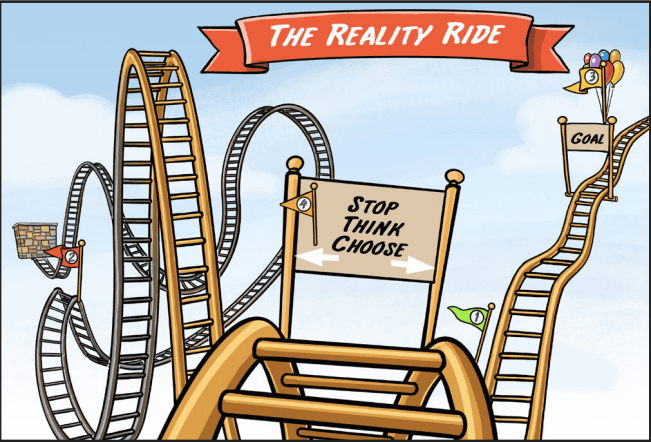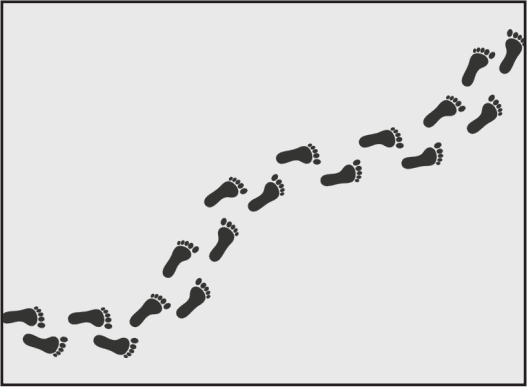Reality Ride Elementary (1-2) Part One
Get Started
With the Lesson Plan PDF
Reality Ride (1-2) Summary:
The Reality Ride Metaphor Walkthrough lessons will be split into two separate lessons. In the first lesson, you will begin by doing the activity, Choose Your Path. This activity will give the students the opportunity to physically evaluate and take two different paths. The experience itself will set the stage for introducing a version of the visual metaphor for the very first time. The activity will highlight the difference between two choices, and how one choice leads to our goal and the other one will not. The one that doesn’t take us to our goal will even look more exciting to choose.
The second lesson will be separate from the activity and we suggest you do it on a separate occasion. This lesson will begin by processing the activity you did before and introducing the visual metaphor. Using the visual metaphor you will help students compare the picture with the activity and ultimately arrive at the idea that we have different choices in life and while sometimes a choice may look or sound fun, it’s important to think about what will get us to where we want to go. We also introduce the idea of Stop, Think, Choose to give students a practical strategy.


Reality Ride Lesson Elements
Part One
- Choose Your Path Activity
Reality Ride Vocabulary
- Choices
- Consequences
- Track
- Easy Fast Decision
- Harder but worth it decision
Reality Ride Learner Objectives
- I can explain that actions have consequences.
- I can explain why sometimes a choice sounds or looks fun, but can actually be a negative choice.
- I can identify choices that hurt me or others.
- I can stop, think, and choose when faced with a choice
Reality Ride Metaphor Walkthrough Part One
Facilitating the Activity: Choose Your Path
Overview:
This activity will help students understand there are different paths (choices) we take that
lead to different outcomes. We get to choose what path we walk each day. As the facilitator, you will set up two different paths ahead of time and then lead them down each path.
Materials:
- Footprints (PDF Provided or use your own) As many copies cut out to create two different paths.
- You need to create two paths ahead of time for students to walk along


Instructions:
The teacher will set up two separate paths ahead of time using the footprint PDF provided with the activity. You print out enough footprints to create a path. We recommend putting footprints every 10-15 feet. You will choose your starting point and then create one path that represents the easy, fast path. This path should look fun and exciting and even involve some parts that may be against school rules (if you feel it would be appropriate). Perhaps it is going over playground equipment or down some stairs or areas of the building students like to play. You can be creative. However, the path will take an unseen turn and should actually lead to a wall or dead end. The second path should look like a much longer path that is also somewhat boring. This will lead to the destination. You may want to throw in some unforeseen moments along that path that are fun, but it is going to be a longer, less extreme path.
Explain to the class that you are trying to get to your chosen destination. There are two paths we can choose to take. Please point out the easy, fast path (without giving it that name) and explain to the kids roughly the route that path will take, making sure to highlight some of the exciting parts of that path. Don’t mention that it actually doesn’t reach the destination but ends up crashing or leading into a wall. Point out the harder but worth it path (without giving it that name) and explain to the kids roughly the route that path will take, making sure to point out the long route it will take.
Ask students to think about which path they would like to take. We would not recommend having them vote or raise their hands. Instead, ask, “Who would like to share which path they would like to take?” Please have a few students share which path they would like to take, and you don’t need a reason why. You will ask them why later. Hopefully you will have at least one that wants to take each path.
Explain you are going to start with the first path (easy-fast). Reinforce your classroom and school rules about walking in a line and then lead them along the path. This should be fun and engaging; however, eventually you will come take the unforeseen turn and end up at the dead end or the wall. Some of the kids in the back of the line may not realize what has happened so have the students gather around and ask the following questions:
Ask these questions:
- Did we get where we wanted to go?
- What do we do now?
Go back to the start and ask the question: “Which path should we take?” Inevitably someone will bring up the other path. Follow the same procedure and take the second path. If you had not included some ‘fun or exciting’ moments along this path that were hidden when you first introduced it, you can also stop along the way and celebrate how far you’ve come. Kids can high-five each other or do a cheer to celebrate along the way.
Eventually, the second path will make it to your destination. At your destination, you should celebrate that you reached your goal. Make sure you use the word goal to describe your destination. This can be a way to introduce the vocabulary word for the first time and explain what it means to have a goal.
Processing Questions:
- Who can remember what path they wanted to take in the beginning? Why did you want to take that path?
- Were their parts of the first path that were fun?
- Where did it lead?
- If that path always leads to crashing into a wall and never reaches your destination should you take that track?
- What was the second track like?
- Were there moments along the second track that were fun? Why did we celebrate at the end of the second track?
- What is a goal?